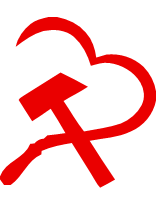This is how I stay somewhat optimistic. I tell myself that if any society has a chance of surviving the future long-term, it will require a type of planning and action that capitalism can't provide. The future is tragic, but there's hope. New spaces will open.
Ah. Well, that's terrifying.
I get the mathematical treatment helping in ways! Glad to see another STEM person into Marx! Since you already got the math down then you could jump into Wright's paper Nonstandard Labor Values or his thesis after feeling comfortable with input output tables. I would also look at his early blog posts to see how he explains it with a simple network of an economy. Whenever I do any of the math for this I always start with drawing a network of labor and product flows, and money flows. Physics trained me to "draw a diagram" and so that's just how I approach this now.
And a reason I appreciate Wright's work is it tries to bring Marx back to Sraffa, while offering a correction to the transformation problem that appears in his work. But I am still not knowledgeable enough to speak of all the divergences. One, is that we can have two different equations for, or ways of measuring, a labor value.
The standard one that Marx works with is a "technical" labor value that isn't commensurate with a measurement of price - it just measures the labor necessary to produce a good solely due to technical requirements of the means of production. The other measure is the non-standard or "institutional" labor value that is commensurate with price (so no transformation problem). This measures the labor necessary to produce a good due to technological and institutional requirements (the 'institution' of capitalist exploitation). When exploitation disappears then non-standard values reduce down to standard values.
If capitalists increase their profit and this profit is realized as use values for the capitalist then it requires workers (somewhere) to work more for the production of these use values compared to the production of their own use values. More surplus value is produced that doesn't go to the workers. But the technical requirements of production have not changed in such a case - so standard values have not changed. If wages are kept constant as profits increase then we see an increase in price (In this model). This price increase can't be explained by the standard measure of value, but can be explained by the non-standard measure. Standard values "stop short" of measuring value commensurate with price.
So some divergences between Marx and Wright may occur where Wright would accuse Marx of working with a standard measure of value when a non-standard measure would apply when discussing price, and vice versa. But I don't think it would change the main conclusions of Max's work.
I would like to go through Capital with this lens and spot any divergences or ways in which this framework may clarify things for me. Just need time, discipline, and probably many lifetimes lol
Thanks for the advice comrade. I'm have that feeling that people will "hate me" and I'm hoping they'll either be happy I'm there or just not care - which are the two more likely outcomes anyway.
The worse case scenario is hell on Earth and my mind doesn't even want to go there.
I've been wanting to find a reading list on why the USSR caved and contrast it to contemporary China to ease my fears - thankfully signs point to China being in such a different and better suited place. I know Hakim has videos on the topic, and one book I know of is Socialism Betrayed, though I haven't read it. Curious if others have good suggestions. And I also don't see the West backing down unfortunately.
I see Kudzu here were I am everywhere so I often think about what needs to be done about it. I appreciate your thoughts on this. I agree with state intervention and a forest ministry. It's amazing what a state can do when if actually has the political will :O
To "save face" I'll still relate it to capitalism through our bourgeoisie class having no ability or desire to do anything useful or good for the world except make line go up something something
I'll take a look at R ulmifolius. I love plants and this sounds like a good rabbit hole for the next hour or so!
Capitalism only knows how to find the worse solution to fuck everything up
I was trying to find some recent update on how much of the convention is planned to be virtual. I haven't found anything definitive but I found a humourous take from a Notre Dame political scientist (always a source for laughs or frustrations) that denies anything would happen. I'm wondering if he's a.) just covering and shoring up confidence, b.) he's just one of many deluded political scientists, or c.) he represents how the dems are thinking about this and they are just this arrogant
From an Article
A key reason for some Democratic leaders preferring to host the convention virtually is the potential for Israel-Palestine protests, which are reminiscent of the anti-Vietnam protests that took place during the 1968 Democratic National Convention — also held in Chicago.
But, according to Layman, this year represents a different time, a different war and vastly different local leadership. “The specter of the 1968 convention hangs over this a little bit since the last time we had these sorts of major campus protests against a sitting Democratic president and his foreign policy was in 1968,” Layman explained.
“But the context was completely different in 1968. We were many years into a very unpopular war with people in their 20s getting drafted into the military, and we had an old-style political machine running Chicago with a more aggressive police department confronting protesters. I think the probability of the Democrats having a repeat of 1968 is very low.”
Don't know where
Don't know when
But I know we'll meet again some sunny day

Every passing day he grows more evil
I wish I had notes written up into some type of primer as a few people have asked for a similar introduction to Sraffa or Ian Wright’s work and I never know exactly what to say. I never found one good introduction, and I’ve had to pick this up from various sources. Note that there is still much I need to learn and blind spots I may have, but here are a set of sources that may be useful for anyone wishing to understand Sraffa, Pasinetti, or Ian Wright’s solution to the transformation problem.
First, much of this relies on knowledge of linear algebra. Any introduction to vectors and matrices can suffice - you don’t need an advanced knowledge of linear algebra. Feel comfortable with vector multiplication with matrices (for left/row and right/column vectors), inverse matrices, and eigenvalues. I know that a hexbear user here lately joked that they get nothing from math videos, but if you do want to refresh your knowledge of intuition of linear algebra then I suggest checking out 3Blue1Brown’s video series on the topic. Personally, I enjoyed how they made the topic visual, and it helped me better understand topics in the field that I only ‘formally’ knew. There’s also Khan academy and many other intros to Lin. Alg.
If you want to jump directly into Ian Wright’s arguments then you could check out his paper Marx’s Transformation Problem and Pasinetti’s Vertically Integrated Subsystems (2019). This is his correction to Pasinetti’s earlier work Growing Subsystems, vertically Hyper-Integrated Sectors and the Labour Theory of Value (1988). These aren’t introductions, though.
As I mentioned earlier, I don’t have a single great introductory work to give you. If others know of one, I’d be happy to check it out! But, one can start by learning Input Output tables. These tables as we know them today were introduced by Wassily Leontief, and though I don’t have a work for introducing Leontief’s Input Output table one can find plenty of sources on this online. Even Wikipedia is not too bad of a place for a basic introduction to them. When you learn how Input Output tables are used then you understand the “quantity equation” in Sraffa’s model. This tells you how much of each product/commodity should be produced overall given some net demand. Sraffa’s model introduces a “price equation” using Input Output analysis that breaks price into wages, costs of materials, and profits. The simplest version of his model ignores fixed capital and assumes purely circulating capital (there are different attempts at how to generalize this to fixed capital).
A tangent on equilibrium before moving on: Some people will criticize Input Output analysis as it assumes equilibrium. While I think it’s obviously important to note that disequilibrium is the norm I sometimes feel those critiques miss the point of Input Output analysis. If one is familiar with dynamic systems then one is likely aware of attractors. These are points or states in some “space” (real space, “economic” space, etc.) which a system tends to evolve toward (or maybe ‘hover’ around). Attractors can tell you something about the structure or behavior of a system even if the system is never at the attractor. I like to think of equilibrium points analyzed in Input Output models as an analysis of this attractor (which can also grow or change with time) in an economic system. The economy may be in disequilibrium at any given time, but its long term behavior, or the direction the system is evolving toward at a given time can be understood by modeling this attractor. Shaikh also discusses this interpretation of equilibrium analysis in his book Capitalism: Competition, Crisis, and Conflict and discusses it as turbulent gravitation and claims this is a view of equilibrium that Classical economists also had. This view of equilibrium in Leontief’s/Sraffa’s models is a view Wright shares as well. Effectively an input output analysis tells us something about the structure of an economy, even if the economy is not in equilibrium at any given moment. Others may disagree, and I’m definitely not an expert - I’m coming at this from a different background than economics. So keep that in mind.
For works on Sraffa, there is his own piece Production of Commodities by Means of Commodites (1960), but the linear algebra notation is not “up-to-date” which can make it harder to read. There is also Passinetti’s Lectures on the Theory of Production (1977) which is a good intro to Leontief and Sraffa and has a good appendix for Linear Algebra, but is likely hard to get a copy of. Another work is Kurz and Salvadori’s Theory of Production. A Long-Period Analysis (1995), though I haven’t given this a read. These works will accept that the labor theory of value is incomplete or incorrect, though. So this is why I recommend “completing” them with Ian Wright’s work if you accept it.
Honestly, though, I started with multiple places. I didn’t start with the above books. One of the first papers I read about this is Ian Wright’s Nonstandard Labour Values (2007). This can be a good place to start once you have a handle on linear algebra as the work is available online. Another is Ian Wright’s own thesis The Law of Value (2015) which you can find online as well. Something I like about how Ian Wright approaches this field is that he uses network diagrams to show the flow of products, labor, and capital. Coming from a Physics field I like some type of diagram to go with any math and description of a system - so that helped me. If you want a non-mathematical argument for Wright’s solution then you can check out Chapter 3 of his thesis. Chapter 7 is his attempt at moving away from static models and toward a dynamic model of the labor theory of value.
Wright also has a blog, Dark Marxism and the earlier pieces provide an introduction to Input Output analysis so you may find that useful as well. In this blog he introduces Pasinetti’s idea of a self-replacing subsystem (i.e. a vertically integrated subsystem) which is another way of approaching an Input Output table.
Wright also has some interesting takes bringing esoteric thought to Marxism, viewing Capital as a egregore or a demon or demiurgic-like entity. So those can be refreshing when you want to take a break from the math. I’ve seen others here on Hexbear link or reference those parts of his work. Politically he seems like a Trot (sad), though I like his writings.
I probably sound like I’m his alt-account or something, so I do apologize for focusing so much on what he has written. But I have learned a lot from reading his papers and I’m still new to the field as well. I do think a solution to the transformation problem is important for Marx’s standing as a science because even here on this post we can see people debating the truth behind the labor theory of value. I see the transformation problem as introducing a crisis of confidence in Marx’s political economy (for some more than others) and so there is importance in resolving it. In relation to profits, the importance of the labor theory of value is these profits, the source of “income” for the capitalists can be shown directly to be the exploited labor of the workers. There is no justification via utility theory or other stances. And political economy can and should be studied from this viewpoint of labor. Exploitation is not some subjective ill (which would be bad enough if it were) but has an objective existence as the pillaging of the real time, energy, and spirit of the working class. Profits are directly related to the amount of this labor that the ruling class steals from us. And a solution to the transformation problem restores our confidence in formally stating this. Hope this was of some help!

Isn't that why they're planning on holding it (or parts of it?) virtualy?
Sorry for the delay, I will respond hopefully tonight!
Trump will literally delete
the existence of food fromAmerica

There are many different interpretations and solutions to the transformation problem (how are values "transformed" into prices). They range from ignoring it, making it more qualitative, reworking the math or definitions of value, etc. I'm not versed enough in all different interpretations, but one that I feel that I "get" and could explain is that offered by Ian Wright. Though his politics are too Trot for me, his correction of the transformation problem makes sense to me and I've wondered about doing a write up on it. It is under the framework of Input Output analysis with natural prices (equilibrium prices that act as an "gravitational attractor" for long term prices, this is also in the sphere of work done by economists such as Sraffa and Pasinetti), and he effectively takes Anwar Shaikh's critique of Sraffa's students (the Neo Ricardians) and applies this critique to their own model to show how the labor values of a good gives you natural prices but it requires care to ensure one is using the appropriate commensurate measure of labor in a commodity.
Effectively his response, and that of Shaikh from what I can tell, is that the profit of capitalists appears as if it comes out of nowhere and can't be explained by the standard definition of labor value in Sraffa's economic model. But the profit that capitalists make (after spending on means of production) get spent back into the economy (in the sphere of circulation) on real use values (say for their class consumption) which have a labor content due to being products of labor. If you "complete that path" of capitalist consumption goods back to their source (labor) and add that labor back into the labor content of a commodity, then boom - labor values march natural prices in Sraffa's own model.
In other other terms: the standard view of a labor value is the amount of labor needed to create one unit of net output (the quantity of goods available for consumption after reinvesting some portion of them as materials for production). So this is labor that's directly required for the production of the unit net good plus labor for the materials required for the unit net good. But, capitalists consume part of this net product and laborers only consume part of it. If the prices of the unit net good matched this measure of labor then prices would be low enough that workers could theoretically buy back with their money-wage their entire net product - leaving none for the capitalists. Some "markup" appears to exist and classical Sraffian model couldn't explain this markup in terms of labor.
But if you measure a "non-standard" labor value (a la Wright) as the amount of labor needed to produce the commodities that only the working class consumes then you get a labor value that also explains this mysterious "markup".
A non-standard labor value counts the amount of labor that is directly and indirectly required to produce a good due to technical conditions, but also the amount of (surplus) labor that is socially/institutionally required by workers to create their real wage (i.e. their consumed product)
I don't claim to understand all of it, or be the best at explaining it. So my apologies for the difficulties. But it is an explanation that meshes with me, and my math-brain seems to get it (the original papers require knowledge of Linear Algebra). It also "cleans up Sraffa's and Pasinetti's economic work and brings that back into alignment with Marx.
Wright also has a dynamic version of this description which better gets at what is usually meant when people say a labor theory of value (the feedback loop between prices, values, and social division of labor)
But with Trump we'd have two genocides, maybe even three. 



